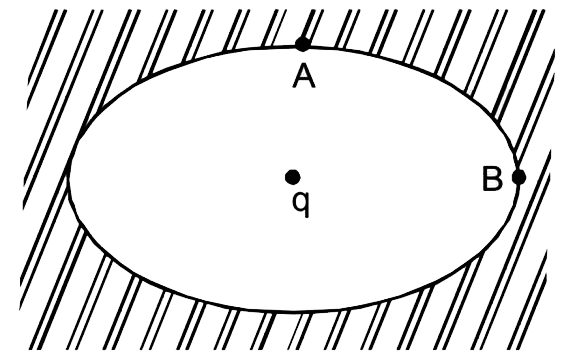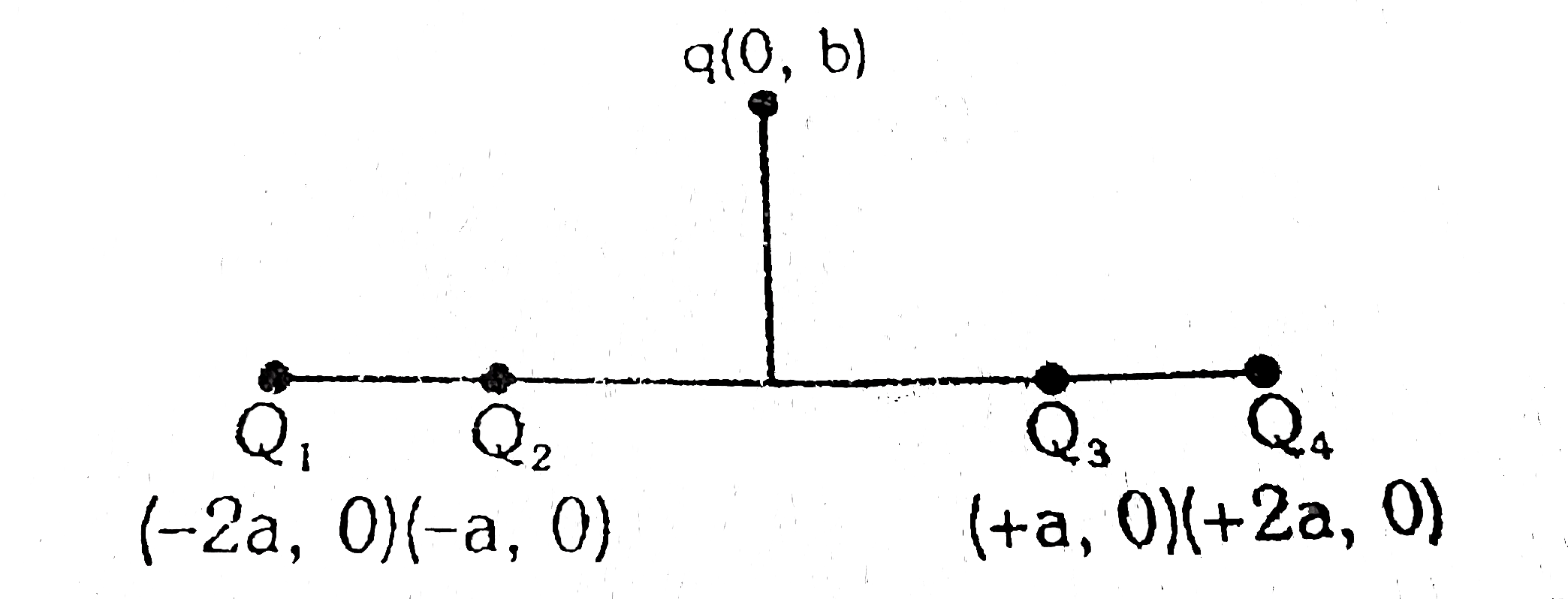An ellipsoidal cavity is carved within a perfect conductor. A positive charge q is placed at the centre of the cavity. The points A and B are on the cavity surface as shown in the figure. Then
 Solution in Gujrati
Solution in Gujrati
electric field near a in the cavity = electric field near B in the cavity
charge density at A = charge density at B
potential at a = potential at B
total electric field flux through the surface of the cavity is q/ε0
The correct Answer is:C
Under electrostatic condition, all points lying on the conductor are in same potential. Therefore, potential at A=potential at B. Hence, option (C) is correct. From Gauss theorem, total flux through the surface of the cavity will be qε0
Topper's Solved these Questions
- MISCELLANEOUSBOOK - ALLEN CHAPTER - MISCELLANEOUSEXERCISE - REASONING TYPE
1 Videos
- MISCELLANEOUSBOOK - ALLEN CHAPTER - MISCELLANEOUSEXERCISE - MATCH THE COLUME TYPE
1 Videos
- MISCELLANEOUSBOOK - ALLEN CHAPTER - MISCELLANEOUSEXERCISE - Exercise-05(B)
19 Videos
- KINEMATICS (MOTION ALONG A STRAIGHT LINE AND MOTION IN A PLANE)BOOK - ALLEN CHAPTER - KINEMATICS (MOTION ALONG A STRAIGHT LINE AND MOTION IN A PLANE)EXERCISE - BEGINNER S BOX-7
8 Videos
- PHYSICAL WORLD, UNITS AND DIMENSIONS & ERRORS IN MEASUREMENT BOOK - ALLEN CHAPTER - PHYSICAL WORLD, UNITS AND DIMENSIONS & ERRORS IN MEASUREMENT EXERCISE - EXERCISE-IV
7 Videos
Similar Questions
statement 1 : For practical purposes, the earth is used as a reference at zero potencial in electrical circuits. statement 2 : The electrical potential of a sphere of radius R with charge Q uniformly distributed on the surface is given by Q4πε0R.
View SolutionFour charges Q1,Q2,Q3 and Q4 oof same magnitude are fixed along the x axis at x=−2a,−a,+a and +2a, respectively. A positive charge q is placed on the positive y axis at a distance b>0. Four options of the signs of these charges are given in List I. The direction of the forces on the charge q is given in List II. Match List I with List II and select the correct answer using the code given below the lists.

List-IList-II(P)Q1,Q2,Q3,Q4all positive(1)+x(Q)Q1,Q2 positive, Q3,Q4 negative(2)−x(R)Q1,Q4 positive ,Q2,Q3 negative(3)+y(S)Q1,Q3 positive , Q2,Q4 negative(4)−y
View SolutionA charge +q is fixed at each of the points x=x0, x=3x0, x=5x0,…………x=∞ on the x axis, and a charge −q is fixed at each of the points x=2x0, x=4x0, x=6x0, …………x=∞. Here x0 is a positive constant. Take the electric potential at a point due to a charge Q at a distance r from it to be Q/(4πε0r).Then, the potential at the origin due to the above system of
View SolutionA football player kicks a ball at an angle of 30∘ with an initial speed of 20 m/s. Assuming that the ball travels in a vertical plane, calculate (a) the time at which the ball reaches the highest point (b) the maximum height reached (c) the horizontal range of the ball (d) the time for which the ball is in the air, (g=10m/s2)
View SolutionAssertion : Gravitational forces do not depend on the medium between the masses.
Reason : Mediating particle responsible for gravitational force is graviton.
View SolutionAn ellipsoidal cavity is carved within a perfect conductor. A positive charge q is placed at the centre of the cavity. The points A and B are on the cavity surface as shown in the figure. Then

View SolutionAsseration: A point charge q is placed at centre of spherical cavity inside a spherical conductor as shown. Another point charge Q is placed outside the conductor as shown. Now as the point charge Q is pushed away from conductor, the potential difference (V_(A) - V_(B)) between two points A and B within the cavity of sphere remains constant. Reason: The electric field due to charges on outer surface of conductor and outside the conductor is zero at all points inside teh conductor.
View SolutionThere is a conductor with cavity of radius R as shown in figure. A point charge Q is placed at R/2 distance from centre of cavity.
A point P is at r distance from centre of conductor. Then,

View SolutionA spherical metallic conductor has a spherical cavity. A positive charge is placed inside the cavity at its centre. Another positive charge is placed outside it. The conductor is initially electrically neutral. {:(,"Column I (Cause)",,,"Column II (Effect)"),((A),"If outside is shifted to other position",,(p),"Distribution of charge on innner surface"),(,,,,"of cavity charges"),((B),"If inside charge is shifted to other position",,(q),"Distribution of charge on outer surface of"),(,,,,"conductor charges"),((C),"If magnitude of charge inside cavity is",,(r),"Electric potential at the centre of conductor"),(,"increased",,,"changes due to charges present"),(,,,,"on outer surface of conductor"),((D),"If conductor is earthed",,(s),"Force on the charge placed inside"),(,,,,"cavity changes"):}
View SolutionA spherical metallic conductor has a spherical cavity. A positive charge is placed inside the cavity at its centre. Another positive charge is placed
View SolutionA conductor A with a cavity as shown in Figure is given a charge Q. Show that the entire charge must appear on the outer surface of the conductor.
View SolutionA conductor having a cavity is given a positive charge. Then field strength EA,EBandEC at point A( within cavity ), at B ( within conducutor but outside cavity ) and C( near conductor and outside ) respectively will be :
View Solutionएक पूर्ण चालक के भीतर दीर्घवृत्ताकार गुहिका (elliptical cavity) काटी जाती है। गुहिका के केन्द्र पर एक धन आवेश q रखा जाता है। गुहिका के पृष्ठ पर दो बिन्दु A तथा B चित्रानुसार स्थित हैं, तब

View SolutionAn ellipsoidal cavity is carved with in a perfect conductor. A positive charge q is placed at the centre of the cavity. The points A and B are on the cavity surface as shown in the figure then (a) Electric field near A in the cavity = Electric field near B in the cavity (b) Charge density at A= Charge density at B (c ) Potential at A= Potential at B (d) Total electric flux through the surface of the cavity is q//epsi_(0) .
View SolutionAn uncharged conductor of arbitrary (non-spherical)shape, has a spherical cavity with a point charge q kept at its centre. The induced surface charge densities at outer surface of conductor and inner surface of cavity in electrostatic condition are respectively
View SolutionAn ellipsoidal cavity is carved with in a perfect conductor. A positive charge q is placed at the centre of the cavity. The points A and B are on the cavity surface as shown in the figure then a) Electric field near A in the cavity = Electric field near B in the cavity b) Charge density at A = Charge density at B c) Potential at A = Potential at B d) Total electric flux through the surface of the cavity is q//epsilon_0 .
View Solution
